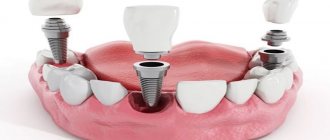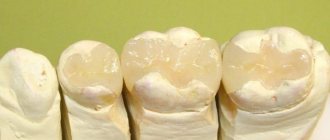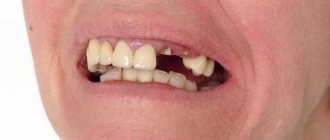Anchor pins
A great variety of anchor pins are used in dentistry:
- by material of manufacture: titanium, steel, brass, fiberglass;
- according to the method of fixation: active (with an active sharp thread, like a self-tapping screw), passive (smooth, stepped ribbed) and something in between (with a smooth blunt thread);
- in shape: cylindrical and conical (with different tapers);
- In addition, each manufacturer produces pins of its own original design in different sizes and claims that its pins fit all pins.
But such diversity does not confuse dentists. Anchor pins appeared on the Russian market quite a long time ago, and each of us already clearly understands the indications and contraindications for this or that type of pin. Anchor pins significantly expand the dentist’s capabilities and can be used both for tooth restoration using photopolymer material, and for restoring the “stump” of a tooth for a crown.
Pin or inlay: which is better to choose for a dental crown?
Currently, different types are used in dental practice to restore the integrity of the dentition. If the tooth tissue is severely damaged, in many cases there are no conditions to fully fix the dentures. This is why various reinforcing structures are used. Such devices are fixed in one part in the root system of the destroyed element, the second part is a support for the crowns. Such devices include anchor and parapulpal pins, as well as stump inlays. When choosing whether a pin or an inlay is better for a crown, you should understand the features and advantages of each product.
Anchor pin
A large number of different anchor pins are used in dental practice; they differ in the following parameters:
- the material from which they are made. Products made of titanium, steel, brass, and fiberglass are used in the production of devices;
- fastening method: devices with active sharp threads, like self-tapping screws, passive - smooth or stepped surface, medium - blunt smooth thread;
- shape - cylindrical and conical.
In addition, each individual manufacturer is characterized by pins of only its brand; they are different. Thanks to anchor pins, the capabilities of dentists in prosthetics have significantly expanded, since such products can be successfully used both for restoring units using photopolymer materials and for restoring tooth stumps for the installation of crowns. Prostheses on pins of this type are used more often for restoration of the masticatory group, but in advanced cases they can also be used for the frontal group.
Parapulpal pin
The parapulpal pin is small in size and is used to reinforce a filling in its own unit. This pin crown is fixed parallel to the dental cavity so as not to touch the nerves. Such a crown with a pin is used to restore the frontal group of living units. For the production of such products, titanium alloys are used; some devices have ceramic linings, due to which they are not so noticeable in the thickness of the filling.
If the crown of your own tooth is severely damaged, it cannot be restored using a traditional filling; special pin structures or orthopedic inlays are used. The question of what is better to choose, a pin or an inlay, is often posed to dentists. And in each specific case, indications, contraindications, disadvantages and advantages are taken into account.
Pros and cons of using a pin
Intraradicular reinforcing agents have been used in dental practice for a long time. Most often, titanium structures are used, which are embedded in the root part of the tooth; their main task is to strengthen the destroyed unit and filling. But according to many experts, such a pin for a crown also brings harm, since such a product requires a strong expansion of the root canal, and in this case one has to sacrifice the mechanical strength of the root system.
Often, treatment with such a design entails a fracture of the root part of the element, in which case complete removal of the element will be necessary. And the removal of such units is difficult and problematic for many specialists.
Dental construction on a fiberglass pin has proven itself much better. This product has increased plasticity and its characteristics resemble natural dentin. Also, a material such as fiberglass can bond much better with filling agents. The fiberglass pin crown is most often used for the restoration of severely damaged anterior units that are not subject to increased load during the masticatory function.
The positive aspects of using a pin include:
- No need to prepare large amounts of dentin.
- Low cost compared to tabs.
- Treatment can be completed in one visit to the dentist.
The disadvantages of such devices include:
- There is no chemical bond between the root and the crown, so these elements are easily separated.
- If the product is installed poorly, or the chewing load on the rod is too high, the root system may be deformed and the surrounding tissues may become necrosis.
- During the process of screwing in the rod, there is an increased risk of damage to bone tissue.
What are stump inlays?
The stump insert consists of a pin and the missing part of the tooth, which are made individually in each case; they are cast from metal. How are such models made? The area in which the tabs are placed is prepared in the same way as for the pin. After which the specialist fills the cavity using special substances (most often ashless plastic), simulating the missing tissue. After the mass hardens, it is removed and sent to a dental laboratory.
Next, the metal product is cast using a plastic template. In the production of devices, chromium-cobalt and chromium-nickel alloys, as well as alloys of precious metals, are used. After the inlay is made, it is transferred to the dentist’s office, after which the selected and manufactured crown is installed on the tooth.
Classification of tabs
A tooth crown can be placed on the following types of inserts:
- non-separable products. They can be made into a single-root unit, consisting of one part;
- collapsible devices. Can be produced in two and three-root units. Consist of a main part and several locking pins;
- device based on zirconium dioxide. To place a crown on the frontal group, metal-free ceramics are used. This material has increased transparency, which is similar to natural dentin.
After the structure is manufactured in a dental laboratory, it is attached to the root system using composite materials. What to do and what to use is decided by a specialist in each specific case.
What's better
What is better to use for dental restoration - an inlay or a pin? It makes no sense to choose among such devices, since each of them has certain advantages and disadvantages. Therefore, the choice is up to the dentist. But there are certain conditions that are common to both inlays and pins:
- Both devices are inserted only into a previously depulped unit (the nerve is removed and the canals are filled).
- It is very important to treat the canals well so that the specialist installs the device efficiently (this procedure will minimize the risk of relapse of chronic periodontitis, which can lead to tooth loss).
- To prepare the bed for both products, the same tools and techniques are used.
If we compare a tooth with a pin or with an inlay, the latter option has more positive aspects of use. They are produced using the indirect method, in a dental laboratory using a pre-made template. The result is a durable product with which you can restore both the frontal and chewing groups. Such a device is inferior to a pin only in long manufacturing times and complex installation.
The positive properties of using stump inlays include:
- The strength of the materials used allows us to prevent breakage or chipping in the future (so that the crown does not fly out under increased chewing loads).
- Uniform distribution of load during the chewing function.
- There is no compression on the root system.
Negative properties of devices include:
- Lack of treatment in one visit to a specialist.
- More tissue needs to be prepared.
- High cost, which is not affordable for every patient.
What to do is decided by a specialist in each specific case. It can be summarized that the stump tab is a more reliable, durable, durable and aesthetic device that is installed for further prosthetics. Even despite the high cost, you can count on a long service life of such a device, while the pins need correction.
Chief author and editor-in-chief: Makarskaya S.E., 29 years of experience.
Stump inlays
They are a classic example of the fact that everything new is well forgotten old. They were used back in the days when the Soviet dentist could not even think about anchor pins. True, the technology for their production left much to be desired. As a result, after the fall of the Iron Curtain, the appearance of anchor pins created a real sensation among dentists and inlays were forgotten for a while.
But a few years later, when they encountered the first complications, many doctors almost completely abandoned the pins and returned to inlays. By that time, high-precision casting technology “came” to us from Germany, ashless plastics and ashless pins appeared, which, unlike previously used wax, do not deform and allow the production of a stump insert of any length and shape.
Features and types of tabs
In appearance and properties, a ceramic microprosthesis is practically no different from a real chewing tooth. It is installed on the upper and lower parts of the rows, which are subject to heavy loads.
Products are manufactured using 3D modeling according to individual indications. A dental impression is first made, the data of which the doctor enters into the program. The computer displays the appearance of the future product. It can be corrected and a shade matched to the patient's enamel can be selected.
The design is usually completed within a week. During this time, the patient is given a temporary filling to protect the tooth from damage. There are two types of all-ceramic inlays, differing from each other in material and manufacturing technology:
- Made from pressed ceramic. They are produced using porcelain injection molding under pressure and high temperature. These are aesthetic products, practically indistinguishable from natural teeth.
- High-tech structures made of zirconium dioxide. In appearance they are not inferior to porcelain inlays, and in strength - to metal ones. Their production is fully automated, and there is no human factor. When they are installed, the gap between the dental tissue and the inlay is minimal, which prevents the occurrence of secondary caries.
Not long ago, dentists began using metal-ceramic inlays to restore teeth. They are no different in cost from all-ceramic ones, but they hold up much worse. Their loss occurs because metal and ceramic have different coefficients of thermal expansion. Since the microprosthesis occupies only a small part of the tooth, it quickly falls out.
The process of restoring a tooth with an inlay is quite complicated. The doctor performs it in the following order:
- removes old fillings;
- grinds the surface of the tooth;
- checks, using special means and instruments, how well the damaged tissue has been removed;
- carefully grinds and smoothes the surface for installation so that the inlay fits as tightly as possible;
- takes an impression, which is then transferred to the dental technician;
- After the microprosthesis is manufactured, it is installed using special types of glue.
In the process of tooth processing, many special compounds are used: polishing pastes, etching gels, preparations for hardening glue and others. To ensure that the insert holds as firmly as possible, all products must be used exactly according to the instructions. After installation of a microprosthesis, the patient must follow special oral care rules. This will increase the service life of the ceramic inlay on the tooth.
What is a “stump tab”?
This is the post and missing part of the tooth, custom made and cast from metal. The bed for the inlay is prepared in the same way as for pins (with special reamers for 2/3 of the length of the root). Then the doctor, like a sculptor, using a special ashless pin and ashless plastic fills the intra-root bed and completes the missing part of the tooth. After the plastic has hardened, the entire conglomerate is removed from the tooth and transferred to a foundry, where the plastic is converted into metal using the lost-wax casting method. For the manufacture of stump inlays, chromium-cobolt, chromium-nickel alloys and an alloy of precious metals are used. This is the so-called direct method. There is also an indirect method, in which the doctor takes an impression of the tooth, and the dental technician makes the inlay.
When is the installation of a dental pin indicated?
A pin is a factory-made rod that is used to restore a damaged tooth. Products are made from different materials, the vast majority of metal. They are installed only in a pulpless tooth in the root canal, fixed with cement or filling material. Next, restoration work is performed - the doctor restores the crown part of the tooth.
During an examination of the patient, the dentist assesses the degree of tooth decay that requires restoration. If there are carious cavities, the doctor will simply fill the tooth after cleaning them, but if the pulp had to be removed, the destroyed walls may require more complex manipulations. There are the following criteria by which the doctor evaluates the destruction of the crown (the visible part of the tooth):
- less than 30% - it is enough to fill the tooth,
- from 30 to 50% - it is recommended to install a pin,
- from 50% - it is possible to install a pin and a crown (according to Akhmedov, Richmond or Ilina-Markosyan).
To restore a tooth under a crown
Most often, a crown is attached to a restored tooth that cannot withstand prolonged stress. Under the crown, hard tissues are well preserved from further destruction; in addition, the design helps the filling stay in place. However, sometimes even an artificial crown does not guarantee that the restored tooth will be able to effectively perform its functions.
For example, the visible part of a tooth is almost completely destroyed, but the root part is quite strong. In this case, the pin is first installed, then the metal tab is attached, and only then the crown. The tripod is fixed using different techniques, which are named after the doctor who proposed this method - Richmond, Logan, Davis.
To install a seal
If a tooth is 30-50% destroyed, but part of its walls are still in place (2-3 out of four), you can do without a crown. It is recommended to install a pin frame. In this situation, the rod will allow you to more effectively distribute the chewing load on the tooth, which will allow the filling to last longer. An important task for the dentist is to correctly fix the structure so that it strengthens the filling in the weakest place.
Other goals
Sometimes pins are used to install dentures. In essence, this is a pin base, similar to the one that is prepared for a crown. However, instead of filling material, a stump inlay is used, which plays the role of a missing tooth. A metal-ceramic crown is placed on the stump. The result is a prosthesis that is attached to the root base. A tooth with a pin and stump is a good restoration method, an alternative to which is tooth extraction and implant installation.










